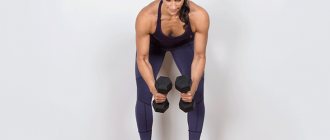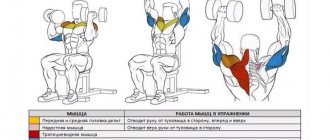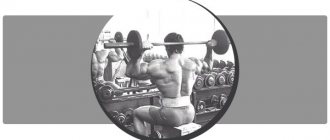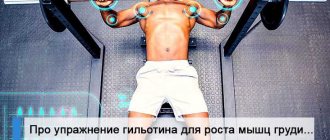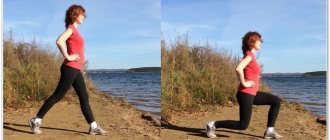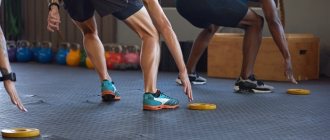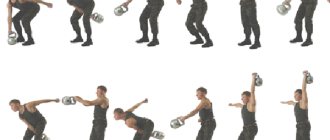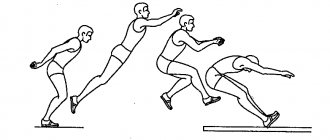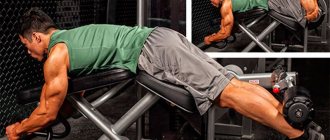Execution technique
Forward bends are at the initial level of difficulty. The technique must be perfect to avoid injury and get the most out of your training.
Forward bends
Proceed as follows:
- Stand up straight and straight. Feet shoulder width apart.
- Tighten your abs. Tilt your body down. The work is done in the hip joints. The back remains straight.
- Having reached the lowest point, stay there for a while.
- Using your gluteal muscles, return to the starting position and repeat the required number of times.
If flexibility is poorly developed and you cannot reach the floor, then you are allowed to bend your knees. With regular training, your flexibility will improve and you will be able to easily perform with straight legs. Overweight girls do it to lose belly fat.
After mastering this exercise, it is recommended to use weights, for which dumbbells and barbells are used.
With a barbell
To practice the technique of bending over with a barbell, a minimum weight or an empty bar is suitable. It is done like this:
- Place your feet shoulder-width apart. Place the barbell just below your neck.
- Straighten your shoulders and bend your knees. Only experienced athletes can perform forward bending from a standing position with straight legs and a barbell.
- Slowly lower your body until it is parallel to the floor. The pelvis is retracted.
- Using your buttocks and thighs, return to the starting position.
The level of inclination depth is adjusted by the hamstrings. You should not try to make the bend deeper if this stretch does not correspond to your level of training.
With dumbbells
Such weights are usually used by girls. For this exercise you will need 2 dumbbells of the required weight.
- Take the starting position: feet shoulder-width apart, back straight, shoulder blades pulled together, and take dumbbells in your hands and place them along your body.
- Lean forward while keeping your back straight. Move your pelvis back. If it is not possible to straighten your legs completely, then bend them at the knees.
- Return to the starting position. It is recommended to repeat 3-5 approaches 10-12 times.
When performing it, it is important to monitor your breathing. Doctors have different opinions on this issue and it is better to focus on the characteristics of the body.
In a standing position, the chest is expanded, and the lungs are able to accommodate the maximum amount of air. In an inclined position, the opposite is true. Therefore, it is recommended to bend as you exhale and return to the starting position as you inhale.
Procedure for performing the exercise
How to do leg bends correctly? Before performing the exercise, do a short warm-up. A series of arm swings, walking in place and hip rotations will not take much time and will prepare your body for the upcoming load.
The movement can also be used at the end of a workout, in which case it will be even more effective. This is explained by the fact that warmed muscles are more amenable to stretching.
- Lower yourself onto your buttocks and straighten your legs in front of you. Pull your socks out and point them towards you. Press your shins to the floor surface.
- As you exhale, bend forward slightly, keeping your back straight. Grab your shins or knees with your palms.
- Using your hands, begin to gradually move forward. Your goal is to lengthen the spine, following the crown forward and upward. Don't try to go down with a rounded back, as this exercise won't do you any good.
- Relax and, as you exhale, press your stomach as close to your legs as possible, literally bending in half. At the same time, stretch the top of your head forward. Don't hold your breath or strain your shoulders. Hold this pose for 30–60 seconds. After a few sessions, you can increase the time spent in this position to 2 minutes.
- It is very important to exit the pose correctly. Perform each movement slowly, the entire exit should take several breathing cycles. Slightly move your lower back back, raise your head, bend your chest and back. After this, begin to slowly rise up - vertebra by vertebra. As a result, your back should be perpendicular to the floor.
Features of the technology
To make the exercise more comfortable, take into account the following recommendations. These tips will help you if you are unable to perform the inclines due to their difficulty.
Before you begin to stretch, slide your heels forward along the floor. This will allow you to pull your buttocks back. As a result, your body will take a more comfortable position.
Try to breathe as deeply as possible and at a comfortable pace. Maintain concentrated tension in your legs, but relax your shoulder girdle and arms in time. This exercise is very useful. It will teach you to feel your body better, relaxing some muscle groups and tensing others.
In order to effectively stretch your spine, try to rotate your hips inward and spread your buttocks in different directions.
Technique
Slowly lean forward until it is comfortable for you.
Legs are straight or slightly bent at the knees. Body weight is evenly distributed on the feet from toes to heels. Keep your head down and look at the floor throughout the entire torso bend exercise.
Inhale, direct the air into the stomach if you know how to do this - without allowing the chest to expand and the torso to rise. Squeeze your buttocks together as hard as possible; if you find it difficult to do this, imagine that you are holding a coin between them and clench your fists until your knuckles turn white. Stay in this position for one second.
Exhale, releasing air and tension at the same time. Think of the sudden pop and deflate effect of a tire when you get a puncture. If you read the book carefully, you know that your body will drop down a little and at the same time the muscles of its back surface will stretch: the gluteal muscles, the hamstrings, but to a greater extent the muscles of the lower back.
To protect yourself from hyperventilation and dizziness, wait a couple of seconds before breathing in again.
Repeat the exercise of bending your torso in front until you can no longer bend lower or you begin to feel some discomfort - dizziness, heaviness in the head, discomfort in the back. For some exercisers, being in a head-down forward bend position is definitely a bad idea; talk to your doctor about whether you should do this exercise.
When you've reached your maximum range of motion for now, or you've simply had enough reps completed, bend your knees and lower yourself into a half-squat before returning to an upright position.
This is very important to ensure safe training for your back!. Scientists have discovered that when your spine is bent too far or your back is too rounded, the muscles in your lower back simply shut down, leaving all the work of supporting the spine to the ligaments
This means two things for you: first, if you try to return to the original vertical position from a very low bend, using your back muscles and keeping your legs straight at the knees, it is very likely that you will get injured. Secondly, in order not to stretch your ligaments, you will not hang in a relaxed state for a long time in the intervals between contractions of the trained muscles. Therefore, bending the torso forward is a very useful and necessary exercise for your body.
Scientists have discovered that when your spine is bent too far or your back is too rounded, the muscles in your lower back simply shut down, leaving all the work of supporting the spine to the ligaments. This means two things for you: first, if you try to return to the original vertical position from a very low bend, using your back muscles and keeping your legs straight at the knees, it is very likely that you will get injured. Secondly, in order not to stretch your ligaments, you will not hang in a relaxed state for a long time in the intervals between contractions of the trained muscles. Therefore, bending the torso forward is a very useful and necessary exercise for your body.
Seated forward bends with a barbell
Bend forward from a sitting position with a barbell - a bodybuilding exercise that is performed to work the erector spinal muscles. When performing it, the gluteal muscles receive an indirect load.
Technique:
Nuances
There are a number of recommendations that should be followed when performing the exercise.
- Don't try to do the exercise with your legs straight straight away. This mainly applies to barbell bending. Over time, the stretch will improve, allowing you to bend over with your legs straight.
- If bending is carried out with a barbell, then the weight should be optimal. With it you should repeat 6-8 high-quality inclinations using the correct technique.
- Watch your breathing.
- Do not make sudden movements when bending over. This is often the cause of spinal injury.
Taking these recommendations into account, anyone can master this exercise with the correct technique and develop flexibility.
Advantages and disadvantages
The main advantage of bending is the development of many muscle groups, which become elastic. The spine becomes more flexible and during the exercise the vertebrae move into place, which improves the athlete’s health.
The exercise is ideal for home workouts and has the following beneficial effects on the body:
- improves spinal flexibility and hip mobility;
- improves hamstring stretching;
- strengthens working muscle groups;
- improves blood circulation. Thanks to these beneficial actions, certain diseases are prevented.
Bends from a standing position have a number of advantages. However, there are contraindications for which it is not recommended to perform the exercise. The aggravating moments are:
- problems with the spine, in which tension in the lumbar muscles is prohibited;
- frequent headaches, high blood pressure and vascular diseases.
Absolute contraindications include the following conditions:
- intervertebral hernia;
- radiculitis;
- pathologies of the respiratory system, including allergies;
- lower back pain;
- pregnancy. In this case, the exercise is strictly prohibited.
The benefits and harms of exercise are quite large. In order not to cause harm to your health, you need to consult a doctor and get permission to exercise. This is especially true for athletes with back problems.
Benefit
You will be interested in: Why do you want to sleep after training: reasons, how to eliminate?
Before you get acquainted with the technique of bending forward from a sitting position, you must first find out what benefits this exercise provides. While bending, blood circulation in the muscles is activated, they acquire elasticity and become toned. In addition, the body becomes more plastic and flexible, which, in turn, improves gait and posture.
Bend to one leg - Parshvottanasana
- Perform Mountain Pose. We retract the tailbone and open the pelvis in front. Gently guide the lower abdomen towards the spine. We move the ribs away from the upper abdomen, as if lengthening and opening the entire front part of the body.
- Relax your shoulders and stretch the back of your neck, reaching the top of your head towards the ceiling.
- We stretch our arms to the sides and turn our shoulders forward so that our thumbs are turned down.
- We place our hands behind our backs and join our palms in a namaste (prayer) position in the middle of the back behind the heart. We press the outer edges of our palms towards the spine, while moving the inside of our elbows back and opening our shoulders in front.
- We take a deep breath, enjoying the opening of the chest.
- We take a step back with our left foot. To make it easier to maintain balance, place your feet hip-width apart. If balance is not an issue, place the arch of your left foot in line with your right heel. Turn your left leg slightly outward. Rotate your pelvis completely toward your right leg.
- As you exhale, bend slowly forward from the pelvis. Do not lift your chin, lengthen the back of your neck and point your forehead towards your right knee.
- Try to touch your stomach to your right thigh (ideally, you should “lay” your navel on your thigh). Pull your forehead towards your right knee or shin (depending on your stretch level).
- Remember: both legs must remain straight and strong. Your knees should not shake. It is better to bend at your level, without touching your forehead to your knee, but with straight legs, than to bend your knees and touch them and not get enough effect.
- Stay in the pose for several breaths. With each inhalation, lengthen your spine, keeping your pelvis level. With each exhalation, deepen the bend.
- As we inhale, we return to the vertical position. We take a step forward with our left foot and again enter the Mountain pose.
- We repeat the exercise on the other side.
For a simplified version of Parshvottanasana:
- Put your hands on your hips
- grab your elbows behind your back,
- bend your front leg at the knee,
- bend parallel to the floor without lifting your chin.
The gaze in the One Leg Bend pose is directed towards the tip of the nose. The additional effect you get by performing this asana is relaxation. And for this, I think, it’s worth working hard. Remember that the effect that yoga and meditation gives does not appear the next day, but be persistent and you will definitely succeed! Body, mind and soul will develop in complete harmony, you will be healthy and happy!
In order to receive by email the complete free course “Yoga Lessons on “Live Easy!” in the form of audio lessons, leave your details in the form below:
Paschimottanasana Seated Forward Bend
Date: 8/01/2012 / 543
The Seated Forward Bend pose is more difficult than it seems at first glance. By performing this asana, you intensively stretch the entire lower part of the body. The word “paschimottanasana” translated from Sanskrit means “seated forward bend”: “paschima” means “west”, and “otana” means “strong, intense”. In yoga, the back of the body is associated with the fuse, the crown of the head with the north, the heels with the south, and the front of the body with the east. The “reverse” to the Seated Forward Bend pose is the Tilt Airplane pose, which helps stretch the front of the body. The pose “ Seated Forward Bend: The Seated Forward Bend pose is usually performed in the first cycle of yoga classes; it opens the cycle of asanas associated with sitting bends. This is followed by a cycle of shoulder stand, followed by a cycle of bending back. When performing the “Seated Forward Bend” pose, sit on the floor, tilt your body forward, trying to reach your feet with your hands, make sure that your back and knees are straight. Benefits of the “Seated Forward Bend” pose: - The benefits provided by the Seated Forward Bend pose work on the entire body, inside and out. - This pose benefits the entire backside of your body by helping to stretch and tighten the hamstrings, back muscles and spine. - While performing this pose, you perform a delicate massage of the internal organs, which normally improves the functioning of your stomach, promotes the proper functioning of the spleen, liver and pancreas, which makes the Seated Forward Bend pose very useful for people suffering from diabetes and hypoglycemia. - Also the Seated Forward Bend pose helps burn excess belly fat, relax, stimulate your nervous system and help relieve stress and nervous tension. - Performing this pose has a calming effect on the mind and body, will help keep you youthful and energetic, will balance the flow of prana in your body and protect you from diseases , will make you a calmer and more confident person. “Seated Forward Bend” step by step: The “Seated Forward Bend” pose is a position that you will perform better and better time after time. This pose is a great test to determine how flexible your body is.1. Sit on the floor, stretch your legs forward, bring your knees and feet together. Sit directly on your buttocks, straighten your spine; your head, neck and back are in line and perpendicular to the floor.
What not to do!
Other news on the topic:
- Pada Hasthasana: Standing Forward Bend
- Performing Mayurasana: “Peacock”
- Dhanurasana: Bow pose
- Chakrasana Bridge Pose
- Reverse stretches step by step
Paschimottanasana
Tilt to the feet while sitting
Attention! The description of the exercises is aimed at a healthy person familiar with safety precautions. It is better to start yoga classes with the help of an instructor. Inept independent practice can be useless and even destructive for the body.
Execution technique
1Sit on your buttocks, straighten your legs. Point the toes of your feet toward you, pressing the backs of your knees to the floor.
2Grip your shins or knees with your hands - where your hands reach with your back straight.
3Helping yourself with your hands, stretch your back forward and up (but not down!), lengthening your spine.
4Then relax your back and lower it as low as possible towards your feet, continuing to pull the top of your head forward. Arms, neck, shoulders - maximum. Breathe freely for 30-60 seconds, gradually increasing the duration of execution.
5Exit: slightly pull your lower back back, raise your head and, bending in your chest and back, lift up vertebra by vertebra until your back reaches a vertical position.
Tuning
Legs are straight and tense. The kneecaps are pulled up. The feet are directed towards themselves. The back is elongated evenly from the tailbone to the crown. The head reaches for the feet. Hands are relaxed, lying on the floor, or touching the feet (without tension)
Subtleties
Before performing the exercise, you can slide your heels forward on the floor to pull your buttock muscles back a little. Calm your breathing while maintaining tension in your legs. Be careful not to strain your arms; this will teach you attentiveness and awareness, the ability to tense some muscles while relaxing others. To better stretch the spine and open the lower energy center, strive to turn your hips inward, while simultaneously spreading your buttocks to the sides, directing the sacrum and tailbone back and up.
Right
The tilt is performed by “folding” the hip joints.
Wrong
- Do not turn your feet with the soles inward. Hold them as if you were pushing against a wall with your feet.
- Do not rush to touch your forehead to your knees by bending your back.
- Do not pull yourself with your hands under any circumstances - this will smoothly and imperceptibly lead to a lower back injury.
- Don't raise your shoulders.
- Don't bend your knees.
How to make it easier
- Sit in Dandasana, straighten your legs, pull your back up and forward, pushing your lower back forward first! You can help yourself a little with your hands, hold on to your legs. Don't bend your back!
- Completely relax your arms, relax your back, pull your toes toward you, and tighten your knees. The upper body is relaxed, the legs are tense.
- If the condition of your legs and back does not allow you to bend over or even sit with a straight back, you can use a strap for support at first. When pulling the belt, pull your lower back forward, do not bend your back - this can lead to injury.
How to deepen
1. When the tilt becomes deep enough - the stomach lies tightly on the hips (except for cases when the stomach lies on the thighs initially due to its size), you can grab the feet with your palms, press your elbows to the floor and, using your forearms as levers, carefully pull your feet up – towards yourself, further stretching the thoracic spine. 2. When your face reaches your knees, you can extend your arms further, beyond your feet, and clasp the wrist of one hand with the palm of the other. 3. Dynamic form: lie on your back, stretch your arms straight behind your head, stretch your whole body, exhale and rise to a sitting position, continuing to stretch your back following your arms up. Then, folding in half at the hip joints, bend as low as possible towards your feet. Keep your torso straight and extended, do not bend your knees. Remain in the pose for the duration of the pause after exhaling, straighten up with an inhalation, raise your body and smoothly - vertebra by vertebra - lower your back to the floor. The duration of inhalation is equal to the duration of exhalation. During the exhalation pause, do not squeeze your throat!
Effect
Paschimottanasana is a therapeutic yoga pose for the spine. It eliminates stoop and curvature of the spine, rejuvenates the nerves of the spinal column, and has a beneficial effect on the genitourinary organs, intestines, pancreas, spleen, liver and stomach. The asana reduces appetite and improves digestion, tightens the hips and buttocks, reduces the amount of fat deposits on the abdomen, stimulates the endocrine system, and has a beneficial effect on the heart. Regular practice of Paschimottanasana calms the brain, relieving anxiety and mild depression, eliminates the symptoms of menstruation and menopause, and reduces the risk of infertility.
Indications
Diseases of the legs, chronic hemorrhoids, diabetes, disorders of the stomach, liver, spleen, kidneys, intestines and pancreas, constipation, catarrh. Salt deposits, osteochondrosis, spinal deformities. Impotence, claustrophobia. High blood pressure, fatigue, insomnia.
Contraindications
Displacement of vertebral discs, chronic arthritis and lumbosacral radiculitis, asthma, pregnancy, acute pain in the spine.
Paschimottanasana is one of the most important yoga poses for beginners. Mastering it is the key to many other yoga poses, including bending and backbending. Paschimottanasana is extremely beneficial for the spine, but dangerous if performed incorrectly.
Tweet
Muscle work during bending
Contrary to popular belief, frontal bends pump up not only the oblique abdominal muscles. With proper technique, physical exercises involve different muscle groups, and when performing variations of an element, auxiliary muscles are also included in the work.
With the help of body tilts you can effectively develop:
- oblique, rectus and transverse muscles of the abdominal region;
- latissimus dorsi muscles;
- gluteal muscles;
- back of the thigh;
- complex of deep lumbar muscles.
Also, in the process of bending, the stabilizer muscles and extensors of the spine actively work.
I. Constant and progressive forward bending of the torso
A. Diseases of the spine and large joints
Diseases of the spine and large joints are usually accompanied by pain and (or) form a mechanical cause of torso tilt. Vertebral syndrome occurs. (Pathological kyphosis and skeletal deformations in spondylitis, ankylosing spondylitis, trauma, tumors and congenital diseases of the spine, coxarthrosis, rheumatoid arthritis, reflex muscular-tonic syndromes).
Diagnosis
confirmed by neuroorthopedic, radiological or neuroimaging studies.
[], [], [], [], [], [], [], []
B. Postural disorders in late stages of Parkinson's disease and parkinsonism
Standing and walking in a “flexor position”, accelerated steps with the body tilted forward in the context of other manifestations of parkinsonism (hypokinesia, resting tremor, muscle rigidity, postural disorders). A combination of both of the above reasons (joint diseases and parkinsonism) is possible.
[], [], [], [], []
C. Progressive weakness of the extensor muscles
Myopathy involving the muscles of the pelvic girdle and paraspinal muscles is mentioned here rather conditionally, since it causes a forward tilt not of the entire body, but only of the pelvis.
The patient's pelvis, due to weakness of the extensors, tilts forward and the patient, compensatory, in order to maintain an upright posture, leans
back,
forming hyperlordosis. In fact, here the torso is constantly tilted back (hyperextension). In the absence of such compensation, the torso would be constantly tilted forward.
Other diseases accompanied by weakness of the extensor muscles of the trunk, for example, amyotrophic lateral sclerosis (proximal forms or a rare onset of the disease with weakness of the extensor muscles of the back); progressive spinal amyotrophy; dermatomyositis; glycogenosis (type 2, Pompe disease); Carnitine deficiency - for the same reasons, are rarely accompanied by a constant forward tilt of the body. Patients experience difficulty in straightening their torso (for example, after bending over to pick something up) and use “myopathic techniques” to help themselves.
[], []
D. Tilted spine syndrome in the elderly
This syndrome is observed only when standing and walking in people over 60 years of age (“strong spine syndrome”). The syndrome should be differentiated from vertebral syndrome (kyphosis), but passive extension of the trunk in these patients is normal. Some patients may experience pain in the lower back, but they are transient and usually resolve spontaneously as the disease progresses. CT scanning of the paraspinal muscles reveals hypodensity (decreased muscle tissue density). Sometimes a slight increase in CPK is possible. EMG shows nonspecific mild signs of myopathy (not in all patients). The disease is slowly progressive. Its nature and nosological independence have not been fully established.
Exercises to pump up the neck muscles
Such training should definitely become a component of the daily warm-up, regardless of whether it is planned to work the neck muscles that day or not.
It is done like this:
- stand up straight, place your feet approximately equal to shoulder width, and lower your arms freely downwards. Relax the muscles of the shoulder girdle and neck. Slowly bend your head to the right, trying to achieve maximum stretch. Without stopping at the extreme point, return to the starting position and repeat the exercise in the other direction;
- IP is the same as in the previous exercise. Slowly bend your head down, trying to touch your chin to your chest. Without stopping at the end point, return to the IP, fix your head in this position for just a couple of seconds, and bend it back in the same way. Then return to the original one.
Lateral bends: technique of execution
How to do side bends correctly?
First of all, don't take on too much. If you immediately take dumbbells weighing 3 kilograms or more without preparation, you can not only injure the muscles, but also get the opposite effect to the expected one - that is, pump the oblique abdominal muscles too much, as a result of which the waist size will not decrease, but increase.
Although, in order to achieve such a result, months of intense training are needed, and only a few can withstand such a pace. But in any case, it’s not worth the risk and it’s better for girls to start training with 1.5 kg dumbbells.
If you practice at home, you can pour water into 1.5-liter bottles and use them as weight.
Bends to the side to pump up the waist can be done in several ways.
First, standing and sitting, with a barbell instead of dumbbells, and with two dumbbells at the same time or with only one of them. In the first case, they will create a counterbalance for each other, which will help reduce the load and the effectiveness of the exercise. Therefore, professional athletes recommend doing the exercise with one dumbbell.
Options for performing the side bend exercise:
- When training with one dumbbell, you need to take it in your hand with a regular grip, with your palm turned inward. Your free hand should be placed on your waist or behind your head. Inhaling, slowly lower the hand with the dumbbell down, sliding along the side of the thigh. In this case, the body must be bent in a strictly lateral plane. It is not allowed to bend forward or backward. At first, it is better to do the exercise in front of a mirror. The load should be at the same level as the knee and only after that you can return to the IP. After completing 10–15 repetitions, change hands;
- You need to perform side bends with two dumbbells in exactly the same way, with the only difference being that they need to be done alternately, first in one direction, then the other. Watch your posture: your head should be raised, your gaze directed forward. When doing backbends while sitting on a chair, try to lower your hand with the dumbbell as low as possible, and do not forget to linger at the lowest point for a short time, achieving maximum contraction of the oblique abdominal muscles;
- You can start doing side bends with a kettlebell once enough time has passed and your body gets used to the load created by dumbbells. You can also gradually increase the load by performing this exercise with a barbell on your shoulders. Hang one weight plate on each side, secure them with a lock, place the barbell on your shoulders and, gripping it so that your palms are facing forward, begin to perform backbends in one direction or the other. If you want to achieve the same effect as performing side bends with one dumbbell, then hang only one weight and work first one side and then the other.
How else can you work your abdominal muscles?
It is very useful to perform body turns on a special metal flat round apparatus.
If you don’t have one, perform twisting bends, which are called “windmills”.
Here's another good exercise: place your feet slightly wider than your shoulders and bend alternately towards your left leg, then towards the center and towards your right leg.
Do three sets of 15 reps at a moderate pace. This will allow you to work not only the abdominal muscles, but also the back muscles, or more precisely, the lumbar region.
Combine such training with a special diet and within a couple of months you will see the result not only on your scales, but also on the centimeter with which you regularly measure your waist circumference. Good luck!
Recommendations
We would like to end this article with useful tips that will help you make your sports activities not only effective, but also safe.
Now you know how to correctly perform a forward bend from a sitting position, what advantages this exercise has and what types of this movement exist. We hope that the information presented in this article was useful to you and you learned a lot of interesting and educational facts!
Source
Types of physical activity
After mastering the technique of standard body tilts forward, you can move on to studying the varieties of this physical activity. This will not only diversify your workouts, but also increase the tone of the deep muscles, which are difficult to work with regular frontal bends.
Varieties of inclinations can be combined with each other and regularly alternated on different days of training. People who especially need constant low-impact and gentle exercise will be able to independently create personal fitness programs according to their level of physical fitness and depending on their sporting goals.
Variations of the element include the following forward bends:
- springy, with intermittent movements;
- with palms touching the floor surface;
- with dumbbells or a gymnastic ball in front of the chest;
- with a gymnastic stick extended above the head;
- with legs brought together;
- with feet spread wider than shoulder level;
- in the splits (for experienced athletes);
- diagonally to one or the other leg in a standing position;
- to the feet diagonally from a sitting position;
- with chin extension.
Strength exercises: Bend the torso forward, flexion and extension of the arms while lying down
Physical training classes are conducted in sportswear or uniforms, depending on the topic of the class, location and weather conditions.
Occupational safety briefing
Injury prevention is ensured by:
- careful fitting of uniforms, sportswear and shoes;
- checking the serviceability and safety of sports facilities, exercise venues, inventory and equipment;
- maintaining high discipline during classes and competitions;
- advance preparation and use of safety equipment and assistance in performing exercises (techniques) associated with risk and danger;
- taking into account the health and physical fitness of personnel who have suffered from illness;
- constant monitoring of external signs of personnel fatigue;
- explanatory work among personnel about measures to prevent injuries;
- compliance with measures to exclude the possibility of frostbite and other fainting conditions.
The following tasks are solved in the classes:
developing endurance, speed, strength and agility, cultivating determination and courage through training in high-speed movement on different terrain, at different times of the day and in any weather.
Strength Exercises: Forward Bend
Exercise 4. Bend the torso forward.
It is performed lying on your back, hands behind your head, fingers locked, legs secured, tilt your torso forward until your elbows touch your knees and return to the starting position until your shoulder blades touch the floor. The exercise is performed for one minute, slight bending of the legs is allowed.
Bend the torso forward (number of times per minute)
| Group | ||||||||
| Grade | 2 | 3 | 4 | 5 | 6 | 7 | ||
| satisfactorily | 45 | 40 | 35 | 30 | 25 | 20 | ||
| Fine | 50 | 45 | 40 | 35 | 30 | 25 | ||
| Great | 55 | 50 | 45 | 40 | 35 | 30 | ||
Strength exercises: Flexion and extension of the arms while lying on the floor.
Exercise 6. Flexion and extension of the arms while lying on the floor.
The push-up is performed from the starting position while lying down (legs together, body straight). Bend your arms until your chest touches the floor, straightening your arms, and take a lying position. The exercise is performed without stopping.”;
Bending and extension of the arms while lying on the floor (number of times)
| Group | ||||||||
| Grade | 2 | 3 | 4 | 5 | 6 | 7 | ||
| satisfactorily | 45 | 40 | 35 | 30 | 25 | 20 | ||
| Fine | 50 | 45 | 40 | 35 | 30 | 25 | ||
| Great | 55 | 50 | 45 | 40 | 35 | 30 | ||
Bringing the body into a relatively calm state.
The total indicator of the load (duration plus intensity) is the heart rate measured 10 and 60 minutes after the end of the session. After 10 minutes, the pulse should not exceed 96 beats per minute, and after 1 hour it should be 10-12 beats per minute higher than the initial (pre-working) value. For example, if before the start of the lesson the pulse was 70 beats per minute, then if the load is adequate, 1 hour after the end of the workout it should be no more than 82 beats per minute. If, within several hours after training, the heart rate values are significantly higher than the initial ones, this indicates an excessive load, which means it needs to be reduced.
These exercises will help the body recover.
Ex. 1. – standing straight, raise your arms up. Shaking your arms, then lowering them down and bending your torso forward.
Ex. 2. – standing straight, arms down along the body. Shake one leg, performing movements in different planes, while standing on the other leg, then switch legs and do the same with the other leg.
Ex. 3. – standing straight, raise your arms up. Lower your relaxed arms down through your sides while simultaneously leaning forward and crossing your arms in front of you.
